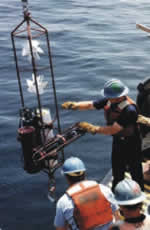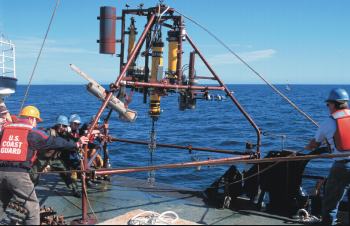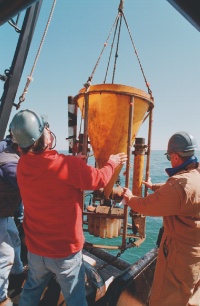 |
 |
Sediment Transport Instrumentation Facility

|
The Sediment Transport Instrumentation Facility at the
USGS Woods Hole Field Center maintains and deploys oceanographic
instrumentation for the study of coastal and ocean circulation and
sediment transport.
The time-series observations are used in studies of regional circulation, to document and understand processes of sediment transport (including major storms and catastrophic events), and provide observations for circulation and sediment transport model testing and evaluation. Instruments are typically deployed for 1-12 months in spatial arrays as part of process or long-term monitoring studies.
The Facility is operated collaboratively with Northeast Fisheries Center of the Woods Hole National Marine Fisheries Service (National Oceanic and Atmospheric Administration , N.O.A.A.) and supports projects throughout the USGS Coastal and Marine Geology Program.
The Facility maintains an extensive and wide range of sensors, data acquisition systems, and systems to deploy and recover instruments in the coastal and deep ocean.

|
Bottom tripod systems (see fig. 2 above) (measures current, pressure, temperature, salinity, light transmission, photographs the bottom, and obtains pumped water samples for analysis of suspended matter).
 |
Acoustic Doppler Current Profilers measures profiles (typically in 1 m bins) of current throughout the water column.
Micro-processor based data loggers for flexible
data acquisition and sensor selection.
Current meters (see fig. 1) suitable for both
near-surface and deep measurements (measures current as well as
temperature, salinity, and light transmission).
Time series sediment traps (see fig. 3) (systems that accumulate suspended sediment over specified time intervals)
Mooring systems for deployment and recovery of instrumentation in the coastal and deep ocean (surface marker floats, subsurface flotation, acoustic releases)
An extensive software system is used to decode,
process, edit, display, archive and analyze data. This system is
developed and maintained cooperatively with the Woods Hole Oceanographic Institution,
and is presently being upgraded to a platform independent system
based on Matlab.
Time series observations collected throughout the U.S.
E.E.Z. since 1975 are archived and distributed to collaborators and
other investigators over the World Wide Web. (see
http://stellwagen.er.usgs.gov)
RECENT PROJECTS:
Massachusetts Bay
Long-term Monitoring
Ecology of Harmful Algal
Blooms
Monterey
Bay Marine Sanctuary, Southern California
Georges Bank
GLOBEC
New York
Pollution
Coastal Sediment Transport Modeling
LINKS TO DATA PROCESSING TOOLS:
Matlab Data Processing Tools
ADCP Processing Toolbox
| Privacy Statement | Disclaimer | Accessibility | FOIA |
 US Department of Interior >
US Geological Survey >
Coastal and Marine Geology >
Woods Hole Science Center
US Department of Interior >
US Geological Survey >
Coastal and Marine Geology >
Woods Hole Science Center

URL: http://woodshole.er.usgs.gov/operations/sedtransfac/index.html
Maintained by: webmaster-woodshole@usgs.gov
Last Modified: Tuesday, 24-Aug-2004 14:13:45 Eastern Daylight Time